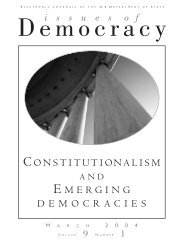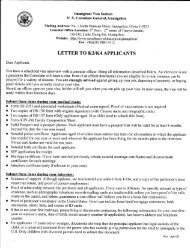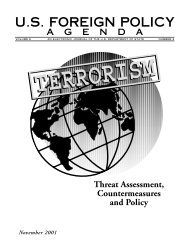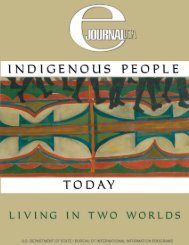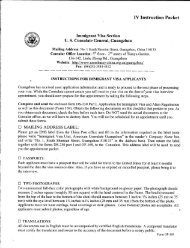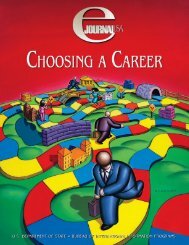s. history us history us history - Embassy of the United States
s. history us history us history - Embassy of the United States
s. history us history us history - Embassy of the United States
- No tags were found...
Create successful ePaper yourself
Turn your PDF publications into a flip-book with our unique Google optimized e-Paper software.
CHAPTER 12: POSTWAR AMERICAOUTLINE OF U.S. HISTORYthat California had displaced NewYork as <strong>the</strong> nation’s largest state.By 2000, Texas had moved ahead <strong>of</strong>New York into second place.An even more important form<strong>of</strong> movement led Americans out <strong>of</strong>inner cities into new suburbs, where<strong>the</strong>y hoped to find affordable ho<strong>us</strong>ingfor <strong>the</strong> larger families spawnedby <strong>the</strong> postwar baby boom. Developerslike William J. Levitt built newcommunities — with homes thatall looked alike — <strong>us</strong>ing <strong>the</strong> techniques<strong>of</strong> mass production. Levitt’sho<strong>us</strong>es were prefabricated — partlyassembled in a factory ra<strong>the</strong>r thanon <strong>the</strong> final location — and modest,but Levitt’s methods cut costsand allowed new owners to possess apart <strong>of</strong> <strong>the</strong> American dream.As suburbs grew, b<strong>us</strong>inessesmoved into <strong>the</strong> new areas. Largeshopping centers containing a greatvariety <strong>of</strong> stores changed consumerpatterns. The number <strong>of</strong> <strong>the</strong>se centersrose from eight at <strong>the</strong> end <strong>of</strong>World War II to 3,840 in 1960. Wi<strong>the</strong>asy parking and convenient eveninghours, c<strong>us</strong>tomers could avoid cityshopping entirely. An unfortunateby-product was <strong>the</strong> “hollowing-out”<strong>of</strong> formerly b<strong>us</strong>y urban cores.New highways created better accessto <strong>the</strong> suburbs and its shops.The Highway Act <strong>of</strong> 1956 provided$26,000-million, <strong>the</strong> largest publicworks expenditure in U.S. <strong>history</strong>, tobuild more than 64,000 kilometers<strong>of</strong> limited access interstate highwaysto link <strong>the</strong> country toge<strong>the</strong>r.Television, too, had a powerfulimpact on social and economic patterns.Developed in <strong>the</strong> 1930s, it wasnot widely marketed until after <strong>the</strong>war. In 1946 <strong>the</strong> country had fewerthan 17,000 television sets. Threeyears later consumers were buying250,000 sets a month, and by 1960three-quarters <strong>of</strong> all families ownedat least one set. In <strong>the</strong> middle <strong>of</strong> <strong>the</strong>decade, <strong>the</strong> average family watchedtelevision four to five hours a day.Popular shows for children includedHowdy Doody Time and The MickeyMo<strong>us</strong>e Club ; older viewers preferredsituation comedies like I Love Lucyand Fa<strong>the</strong>r Knows Best. Americans <strong>of</strong>all ages became exposed to increasinglysophisticated advertisementsfor products said to be necessary for<strong>the</strong> good life.THE FAIR DEALThe Fair Deal was <strong>the</strong> name givento President Harry Truman’s domesticprogram. Building on Roosevelt’sNew Deal, Truman believed that <strong>the</strong>federal government should guaranteeeconomic opportunity and socialstability. He struggled to achieve thoseends in <strong>the</strong> face <strong>of</strong> fierce political oppositionfrom legislators determinedto reduce <strong>the</strong> role <strong>of</strong> government.Truman’s first priority in <strong>the</strong>immediate postwar period was tomake <strong>the</strong> transition to a peacetimeeconomy. Servicemen wanted tocome home quickly, but once <strong>the</strong>yarrived <strong>the</strong>y faced competition forho<strong>us</strong>ing and employment. The G.I.Bill, passed before <strong>the</strong> end <strong>of</strong> <strong>the</strong> war,helped ease servicemen back into civilianlife by providing benefits suchas guaranteed loans for home-buyingand financial aid for ind<strong>us</strong>trialtraining and university education.More troubling was labor unrest.As war production ceased, manyworkers found <strong>the</strong>mselves withoutjobs. O<strong>the</strong>rs wanted pay increases<strong>the</strong>y felt were long overdue. In 1946,4.6 million workers went on strike,more than ever before in American<strong>history</strong>. They challenged <strong>the</strong> automobile,steel, and electrical ind<strong>us</strong>tries.When <strong>the</strong>y took on <strong>the</strong> railroads ands<strong>of</strong>t-coal mines, Truman intervenedto stop union excesses, but in so doinghe alienated many workers.While dealing with immediatelypressing issues, Truman also provideda broader agenda for action. Lessthan a week after <strong>the</strong> war ended, hepresented Congress with a 21-pointprogram, which provided for protectionagainst unfair employmentpractices, a higher minimum wage,greater unemployment compensation,and ho<strong>us</strong>ing assistance. In<strong>the</strong> next several months, he addedproposals for health insurance andatomic energy legislation. But thisscattershot approach <strong>of</strong>ten left Truman’spriorities unclear.Republicans were quick to attack.In <strong>the</strong> 1946 congressional elections<strong>the</strong>y asked, “Had enough?” andvoters responded that <strong>the</strong>y had. Republicans,with majorities in bothho<strong>us</strong>es <strong>of</strong> Congress for <strong>the</strong> firsttime since 1928, were determinedto reverse <strong>the</strong> liberal direction <strong>of</strong> <strong>the</strong>Roosevelt years.Truman fought with <strong>the</strong> Congressas it cut spending and reduced taxes.In 1948 he sought reelection, despitepolls indicating that he had littlechance. After a vigoro<strong>us</strong> campaign,Truman scored one <strong>of</strong> <strong>the</strong> great upsetsin American politics, defeating<strong>the</strong> Republican nominee, ThomasDewey, governor <strong>of</strong> New York. Reviving<strong>the</strong> old New Deal coalition,Truman held on to labor, farmers,and African-American voters.When Truman finally left <strong>of</strong>ficein 1953, his Fair Deal was buta mixed success. In July 1948 hebanned racial discrimination in federalgovernment hiring practices andordered an end to segregation in <strong>the</strong>military. The minimum wage hadrisen, and social security programshad expanded. A ho<strong>us</strong>ing programbrought some gains but left manyneeds unmet. National health insurance,aid-to-education measures,reformed agricultural subsidies,and his legislative civil rights agendanever made it through Congress.The president’s pursuit <strong>of</strong> <strong>the</strong> ColdWar, ultimately his most importantobjective, made it especially difficultto develop support for social reformin <strong>the</strong> face <strong>of</strong> intense opposition.EISENHOWER’S APPROACHWhen Dwight Eisenhower succeededTruman as president, he accepted<strong>the</strong> basic framework <strong>of</strong> governmentresponsibility establishedby <strong>the</strong> New Deal, but sought to hold<strong>the</strong> line on programs and expenditures.He termed his approach “dynamicconservatism” or “modernRepublicanism,” which meant, he ex-268269



